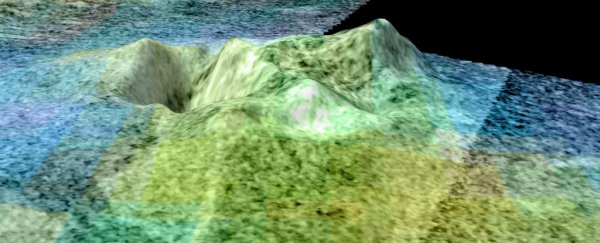On 15 September 2017, NASA's Cassini Orbiter concluded its mission by diving into Saturn's atmosphere.
Over the course of the 13 years it spent studying the Saturn system, it revealed a great deal about this gas giant and its largest moon, Titan.
In the coming years, scientists are eager to send another mission to Titan to follow up on Cassini and get a better look at its surface features, methane lakes, and other curious properties.
These include the morphological features in the northern polar region that are strikingly similar to volcanic features here on Earth.
According to a recent study by the Planetary Science Institute (PSI), these features could be evidence of cryovolcanism that continues to this day.
These findings are the latest evidence that Titan has an interior ocean and internal heating mechanisms, which could also mean the planet harbors life in his interior.
Their study, "Morphologic Evidence for Volcanic Craters near Titan's North Polar Region," was recently published in the Journal of Geophysical Research: Planets.
The study was conducted by Charles A. Wood – a data scientist with the PSI in Tucson, AZ – with the assistance of Jani Radebaugh, a Professor of planetary science at Brigham Young University who was also an associate team member with the Cassini radar science team.
As they indicate in their study, the volcano-like features in Titan's northern polar region are unlike others identified on the moon's surface – such as dunes, rivers, or lakes, all of which are likely the result of atmospheric processes.
What's more, the presence of morphological features – such collapse craters and small depressions – is further evidence of cryovolcanic activity.
The proximity of these features to Titan's famous northern lakes of methane is also quite telling.
As Wood explained in the study: "The close association of the proposed volcanic craters with polar lakes is consistent with a volcanic origin through explosive eruptions followed by collapse, as either maars or calderas. The apparent freshness of some craters may mean that volcanism has been relatively recently active on Titan or even continues today."
As for why these features are found in the northern polar region, with some corresponding depressions in the southern polar region, Woods and Radebaugh have some thoughts on that as well.
Essentially, they theorize that it could be related to how the ice crust around the low-elevation poles are warmer and thinner than in other regions.
Other indications that these features are cryovolcanic in origin include the fact that they are roughly round, have raised rims, and sometimes overlap one another.
This is consistent with what geologists and volcanologists have observed on Earth, as well as the Moon, and Mars. In all three cases, volcanic landforms are linked to geological activity and were formed by explosions, excavations, and collapses.
As noted, this also serves as evidence for an internal heating mechanism, similar to what has been observed on Europa and Enceladus. In both cases, tidal stresses produced by interaction with their host planet ( Jupiter and Saturn) causes heat to build up inside the moons' cores.
This heat then escapes to the surface as plumes of water that break through the icy crust, much the same way that lava breaks through the Earth's crust.
Last, but not least, the features lend further weight to the idea that the interior of Titan could support life.
As Wood added: "That these features are at the polar regions, near the lakes of methane, may indicate methane, nitrogen or some other volatile may power them. The features appear relatively fresh, meaning they could still be forming today."
This research was funded by a grant to PSI from NASA's Cassini mission.
This article was originally published by Universe Today. Read the original article.
